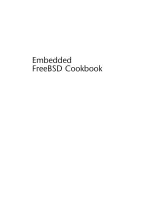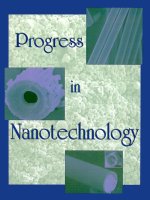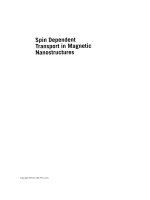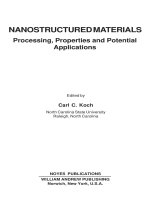cevoli, p. (2002). embedded freebsd cookbook
Bạn đang xem bản rút gọn của tài liệu. Xem và tải ngay bản đầy đủ của tài liệu tại đây (1.13 MB, 249 trang )
Embedded
FreeBSD Cookbook A Volume in the
Embedded T
echnology
™
Series
Embedded
FreeBSD Cookbook
by Paul Cevoli
An imprint of Elsevier Science
Amsterdam Boston London New York Oxford Paris
San Diego San Francisco Singapore Sydney Tokyo
iv
Newnes is an imprint of Elsevier Science.
Copyright © 2002, Elsevier Science (USA). All rights reserved.
No part of this publication may be reproduced, stored in a retrieval system, or
transmitted in any form or by any means, electronic, mechanical, photocopying,
recording, or otherwise, without the prior written permission of the publisher.
Recognizing the importance of preserving what has been written, Elsevier Science
prints its books on acid-free paper whenever possible.
Librar
y of Congress Cataloging-in-Publication Data
ISBN: 1-5899-5004-6
British Librar
y Cataloguing-in-Publication Data
A catalogue r
ecord for this book is available from the British Library.
The publisher offers special discounts on bulk orders for this book.
For information, please contact:
Manager of Special Sales
Elsevier Science
200 Wheeler Road
Burlington, MA 01803
For information on all Newnes publications available, contact our World Wide Web
home page at
10 9 8 7 6 5 4 3 2 1
Printed in the United States of America
Preface vii
Prerequisites and Other Resources vii
1 Getting Started 1
Overview 1
Embedded Systems 1
Internet Appliances 2
Compatibility of upgrades 3
Time to market 4
Labor pool 4
Licensing 4
The DIO Server Appliance 4
FreeBSD 5
GNU Development Tools 6
Java 7
Server 7
Data Acquisition 7
Boot Device 7
Summary 8
2 Systems Programming 9
Overview 9
Process 9
The 10
System Call 10
The 11
System Call 11
The 12
System Call 12
The 12
System Call 12
An Example 12
Process IDs 13
Security 14
An Example 15
The 16
and 16
System Calls 16
File Descriptors 17
Permissions 17
Current Working Directory 17
The 18
and 18
System Calls 18
The 18
System Call 18
Priority 19
State 20
The 20
Function 20
The 21
System Call 21
Daemons 21
Fork 21
Create a new session 22
Close file descriptors 22
Change the current working directory 22
Set the file mode creation mask 22
Handle Child Exit Status 22
The 22
Function 22
The 23
Function 23
Summary 25
3 System Calls 27
Overview 27
Library Functions and System Calls 27
Software Interrupt 29
Passing Data 29
An Example 30
Creating a System Call 32
Load Handler 32
System Call Arguments 34
The 34
System Call 34
The 36
Structure 36
The System Call Number 36
The SYSCALL_MODULE Macro 38
Command Definitions 39
Command Table 40
The 40
Function 40
Command Function Handlers 42
The 45
Program 45
An example 47
Summary 48
4 Device Driver 49
Overview 49
Driver Environment 49
Driver Structure 51
The 52
Structure 52
The 53
Structure 53
The 55
Structure 55
The 57
Structure 57
The 57
Structure 57
The 57
Macro 57
The 58
Structure 58
The DIO24 Device Driver 59
The 61
Function 61
The 62
Function 62
The 63
Function 63
The 64
Function 64
The 66
Function 66
The 66
Function 66
The 67
Function 67
The 68
Function 68
The 69
Function 69
The 69
Function 69
Register Shadowing 71
The 73
Function 73
Summary 76
5 Midlevel Interface Library 77
Overview 77
Shared Libraries 77
Accessing the Device Driver 79
The 80
System Call 80
The 81
System Call 81
The 81
System Call 81
The 82
System Call 82
The 82
System Call 82
PCI-DIO24 Hardware Registers 82
The DIO24 Application Interface Library 87
The 89
and 90
Functions 90
The 92
and 92
Functions 92
The 94
and 94
Functions 94
The diopolarity 95
The 95
and 95
functions 95
The 97
and 97
Functions 97
The 98
Function 98
Summary 101
6 Daemons 103
Overview 103
Introduction to TCP/IP 103
IP Addressing 105
ARP 105
RARP 106
ICMP 106
Ports 106
UDP 106
TCP 107
Socket System Calls 107
Connection Initiation 109
The 111
System Call 111
The 112
System Call 112
The 112
System Call 112
The 113
System Call 113
The 113
System Call 113
The 114
System Call 114
The 115
System Call 115
The DIO Daemon 115
The 115
Structure 116
The 117
Function 117
The 119
Function 119
The 120
Function 120
Summary 122
7 Remote Management 123
Overview 123
Using Secure Shell (SSH) 123
The DIOShell 130
The 132
Function 132
The 133
Function 133
The 134
Function 134
The 135
Function 135
The 136
Function 136
The 137
Function 137
The 138
Function 138
The 139
Function 139
The 139
Function 139
The 140
Function 140
The 141
Utility 141
Summary 142
8 JNI Layer 143
Overview 143
The JDK 143
Creating the JNI Layer 145
The DIOLineState Class 147
The DIOLineNumber Class 148
The DIOLineDirection Class 149
The DIOIfJNI Class 150
The 154
Function 154
The 154
Function 154
The 155
Function 155
The Makefile 155
Summary 156
9 Web Access Using Tomcat 157
Overview 157
Tomcat 157
bin 158
JSP Overview 160
Comments 161
Directives 161
Declarations 162
Expressions 162
Code Scriptlets 162
The DIO JSP Page 162
Summary 165
10 Building the Kernel 167
Overview 167
The 168
Keyword 168
The 168
Keyword 168
The 168
Keyword 168
The 168
Keyword 168
Kernel Options 169
Controllers and Device Drivers 171
Building the DIO Kernel 177
Building the FreeBSD Kernel 180
Summary 182
11 System Startup 183
Overview 183
Disk Geometry 183
Master Boot Record 185
Boot Loader 185
Partition Table 185
Magic Number 187
An Example 187
Unix Partitions 189
PC BIOS 189
FreeBSD Boot Loader 190
init 192
Starting DIO Components 194
Summary 196
12 The CompactFlash Boot Device 197
Overview 197
Solid-state Devices 197
Installing the TARC CompactFlash Adapter 198
Configuring the CompactFlash Device 199
Copying the Files to the Boot Device 201
Startup Configuration 201
Summary 205
A The FreeBSD License 207
B PCI Configuration 209
Vendor ID Register 211
Device ID Register 211
Command Register 211
Status Register 212
Revision ID 212
Class Code 212
Cache Line Size 212
Latency Timer 213
Header Type 213
BIST 213
Base Address Registers 213
CardBus CIS Pointer 213
Subsystem Vendor ID 213
Subsystem ID 213
Expansion ROM Address 213
Maximum Latency 214
Minimum Grant 214
Interrupt PIN 214
Interrupt Line 214
C Kernel Loadable Modules 215
Overview 215
Kernel Loadable Modules 215
System Calls 219
Device Drivers 221
The open Function 225
The close Function 225
The read Function 225
The write Function 226
Commands 226
vii
Preface
Discussing embedded systems in general is dif
ficult, because each embedded
system is unique. Rather than presenting a list of general principles for
handling embedded development issues, this book presents examples of
problems encountered and solutions to those problems using real hardware
and software. In that sense, it is a “cookbook” for developers that offers
design “recipes” that can be elaborated on or modified as needed to solve
other design problems.
In addition to the source code provided to develop the DIO appliance, this
book contains real “how-to” information for obtaining releases of Open
Source software and describes the steps to install, configure and program.
Whether you are developing an actual appliance or experimenting with the
operating system, this book will help you familiarize yourself with all the
development issues, not just development concepts.
This book presents a set of common issues that are encountered during the
development of an embedded web appliance. Each chapter covers a specific
topic, discusses background information on the topic, and presents a design
solution for that topic. The chapters are not meant to present all possible
solutions, but rather provide information that can be used to help develop
your own solutions.
Developing an embedded system involves many skills beyond writing
source code. Identifying technologies that can be used to solve a problem,
installing, configuring, and packing are all skills that are equally important
but are often overlooked. All of these issues are covered, to give you a
complete picture of the embedded development process.
Prerequisites and Other Resour
ces
This is a book about developing an inter
net appliance using FreeBSD and
the software tools contained in the FreeBSD distribution. As such, it assumes
the reader has some background in programming in C and C++ in a Unix
environment. In addition to basic programming skills it would be helpful if
you had a basic understanding of data structures and system programming.
This book is for readers that already know how to write and compile code
viii
and want to lear
n more about the FreeBSD environment and explore topics
that are different from a typical programming book. A few of the topics do
not require that you have a detailed background in computer hardware but
assume you have some knowledge and are willing to learn the skills necessary.
I wrote this book for people who wanted to delve a little deeper into the
FreeBSD operating system. Many of the issues presented in this book go
beyond programming in C or C++ and present issues that an embedded
systems engineer would be faced with during product development. This is
not a book about FreeBSD internals and how to hack the kernel. FreeBSD
has distinguished roots and there are already excellent resources available
to learn about FreeBSD operating system internals and system administra-
tion. I recommend
The Design and Implementation of the 4.4 BSD Operating
System
, The Complete Fr
eeBSD
, and The Fr
eeBSD Handbook
, located at
In addition to these resources, the FreeBSD web site contains numerous mail-
ing lists, user groups, newsgroups and web resources. There are also excellent
references for programming Unix, such as
Advanced Pr
ogramming in the Unix
Environment
and The C Pr
ogramming Language
, both available on amazon.com.
Organization
This book contains 12 chapters and 3 appendices.
Chapter 1,
Getting Started, intr
oduces you to embedded systems and
describes Internet appliances and FreeBSD. Additionally, the major pieces of
hardware and software used to build the Internet appliance described in this
book are covered.
Chapter 2,
Systems Pr
ogramming
, intr
oduces you to the Unix process and
daemons. A process is fundamental to Unix programming. A Unix daemon
is a special type of process. The details of creating a daemon from a Unix
process are discussed.
Chapter 3,
System Calls, describes exactly what a system call is and how it is
implemented in FreeBSD.
Chapter 4,
Device Drivers, pr
ovides a description of FreeBSD device drivers
and their data structures. Tools available to driver writers are discussed and
used to develop an actual device driver for a PCI data acquisition controller.
ix
Chapter 5, Midlevel Inter
face Library
, pr
esents a discussion of shared libraries
and how user code accesses a device driver.
Chapter 6,
Daemons, builds on the topics pr
esented in Chapter 2 by imple-
menting a Unix daemon that uses sockets to provide a simple protocol to
read and write to the data acquisition board.
Chapter 7,
Remote Management, discusses how to pr
ovide a secure method
for remote management. A configuration shell is developed and may be
accessed remotely via SSH.
Chapter 8,
JNI Layer, intr
oduces the user to JNI, an interface to allow Java
programmers to call C code.
Chapter 9,
W
eb Access using Tomcat
, pr
ovides the steps necessary to display
dynamic web content. The procedure for configuring Tomcat, a JSP server,
and writing JSP pages is discussed. You will develop a JSP page that displays
the status of the data acquisition controller.
Chapter 10,
Building the Ker
nel
, discusses the steps for building a
custom kernel based on the hardware and specific features of the DIO
Internet appliance.
Chapter 11,
System Startup, pr
ovides a discussion of the FreeBSD booting
process and modifications necessary to the startup scripts to run the services
required by the DIO appliance such as Tomcat, ssh and loading custom KLDs.
Chapter 12,
The CompactFlash Boot Device, pr
ovides a description of partition-
ing a flash device and loading the code developed in the previous chapters
of this book onto the flash to make a living, breathing appliance server.
Appendix A,
The Fr
eeBSD License
, is a copy of the Fr
eeBSD license.
Appendix B,
PCI Configuration, discusses the PCI configuration space.
Knowledge of PCI configuration registers is needed for developing device
drivers for PCI controllers. The appendix describes the registers in PCI
configure space and their uses.
Appendix C,
Ker
nel Loadable Modules
, covers KLDs, which ar
e used for
system calls and device drivers in Chapters 2 and 4. The appendix provides
x
a discussion of the individual components that make KLDs and their uses.
In order to get the most out of this book, I recommend not getting bogged
down in the details but trying to gain a general understanding of the
topic through studying one way to implement a solution to that topic.
By becoming familiar with each step involved in developing an embedded
system, you should be able to apply the concepts to any development task
you may encounter.
What’
s on the CD-ROM?
The accompanying CD-ROM contains the sour
ce code for the programs
used in the book and a fully searchable pdf version of the entire text.
Conventions
Macro Text
Macr
o text is used for source code.
Bold Macro Text
Bold Macr
o Text is used for program output and shell input.
1
1
CHAPTER
ONE
Getting Started
Over
view
Embedded computer systems permeate all aspects of our daily lives.
Alarm clocks, coffee makers, digital watches, cell phones, and automobiles
are just a few of the devices that make use of embedded systems. The
design and development of such systems is unique, because the design
constraints are different for each system. Essential to the development of
an embedded system is an understanding of the hardware and software
used for development.
Embedded Systems
An embedded system consists of har
dware and software designed to solve a
specific application. Many applications consist of more than simple computer
hardware and software. For example, an industrial vision system designed to
control a robotic arm consists of an embedded computer, camera, display,
and the robotic arm. Each of these components are embedded systems on
their own.
Embedded systems have evolved over the years from simple self-contained,
single-purpose systems to fully integrated, web-aware systems. The rapid
changes in technology and added requirements have caused developers to
take a new approach to the design and development of those systems. Let’s
take a quick look at how the product markets and requirements have evolved.
Classic embedded systems have been considered dedicated solutions to a
single application. In these classic systems, the hardware was custom
designed to solve a specific application and the operating system was
developed internally. All the
software was self-contained
in nonvolatile RAM and
there was a limited user
interface. Examples of these
types of embedded systems
are microwave ovens, MP3
players and cell phones.
As the Internet grew, the requirements
of embedded systems also began to
grow in complexity. In addition to
solving classic embedded systems
problems, system designers were
required to add connectivity for send-
ing and receiving data or providing
an automated method for software
upgrades. Rather than increase the
development effort, system designers
have moved toward using third-party
hardware and evaluating open source
software. Examples of these next-
generation embedded systems are load
balancers, Virtual Private Networks
(VPN) and Ethernet switches.
Internet Appliances
Many of the embedded systems developed today are what would be called
servers just a few years ago. These systems are developed using PC hardware,
run an embedded application, have Internet connectivity, and run network
services for remote configuration. These latest incarnations of embedded
systems are called Internet appliances.
2 Embedded FreeBSD
Cookbook
123
456
789
0
RESET PREHEAT
Press to Open
START STOP
Microwave Oven
Figure 1-1. Classic embedded system
Load Balancer
Server #1
Server #2
Server #3
Clustered Load Balancer
TCP/IP
Figure 1-2. Load balancer
3 Chapter One
Getting Started
Network connectivity r
equires the addition of network protocols, services,
and networking hardware. Web services require the addition of more
complex application software. These additional requirements significantly
increase the hardware cost, development, and complexity of embedded
systems development.
The added performance requirements add scalability to the list of system
requirements, further limiting the choice of solutions of computer design.
Additionally the investment of developing an embedded solution must be
protected; as the hardware evolves, the final choice of hardware and software
must be compatible from release to release. With the rapid development
schedules of the high-tech sector, hardware and software solutions must be
flexible enough to meet the needs of evolving markets and customers.
To address the increased complexity of embedded systems, a new category
has become popular—the appliance server. An appliance server is a network-
enabled embedded computer designed to perform a single task and provide
superior performance and higher reliability than a general-purpose server.
Applications ideal for appliance servers include VPN, network attached
storage (NAS), and load balancing.
Development Issues
While the cost of computer components and time to market continue to
decrease, functionality and features for a typical embedded system continue
to increase. In order to respond to this, many project developers choose to
use third-party hardware and open-source software and develop only those
components that provide value-added features. The classic model of embed-
ded systems development using custom hardware and homegrown operating
systems has been replaced in many of the systems being developed today. Let’s
take a look at a few of the development issues related to embedded systems
relying on third parties for some of the core components.
Compatibility of upgrades
By choosing thir
d-party hardware and open-source software, a system
designer ensures access to compatible technology from multiple vendors and
allows the completed system to be developed quicker and for a lower cost.
Systems designers can focus resources toward developing their application,
rather than keeping resources focused on maintaining the operating system
or developing the next hardware platform.
4 Embedded FreeBSD
Cookbook
T
ime to market
An open-sour
ce operating system reduces the time to qualify and develop
the software solution. The server appliances address increased time pressure
to market and hardware flexibility by using an increasingly rich set of third-
party hardware and software. By relying on readily available hardware and
software, the server appliance developer can focus on solving the application.
Labor pool
The incr
eased complexity of Internet appliances requires the transition from
simple embedded tools to an off-the-shelf integrated development environ-
ment with tools that facilitate the development of secure, reliable, and long-
running systems. Additionally, an off-the-shelf integrated development
environment reduces the time to market, as well as training time.
Licensing
T
raditional real-time operating system software licenses restrict the source
to the licensee and may require a royalty fee for distribution. In contrast,
open-source software licenses allow the licensee to make the software freely
available to anyone who wishes to use it.
The DIO Ser
ver
Appliance
The r
emainder of this chapter dis-
cusses an Internet appliance that will
be developed in this book, the digital
input-output (DIO) server appliance.
The DIO server appliance is an
embedded system that provides the
capability to read and write digital IO
lines. The digital lines are monitored
via the Internet using sockets, a
secure command shell, or a browser.
The software uses an open-source
operating system and tools, FreeBSD
4.4 and the GNU development suite.
The system software and application
Sockets
TCP/IP
System Boot
CompactFlash
Free BSD 4.4
Data
Acquisition
Tomcat
DIO Server Appliance
Figure 1-3. DIO ser
ver appliance
5 Chapter One
Getting Started
ar
e developed in the remaining chapters of this book, presenting the design,
development, and implementation of an actual server appliance.
The hardware to develop the DIO server appliance is a standard PC and a
third-party digital IO data acquisition card. The boot device is a CompactFlash
adapter and CompactFlash card, which can be purchased over the Internet.
Software
FreeBSD
Fr
eeBSD is an optimal solution for Internet appliances and other embedded
systems that require Internet connectivity, networking performance, and
reliability. Additionally, FreeBSD comes with an industry standard set of soft-
ware development and configuration management tools and application
software. It is a Unix-compatible, open-source operating system that offers
unprecedented reliability and security. It runs some of the Internet’s busiest
web sites, such as Yahoo and Hotmail, and supplies the basis of embedded
products like the AMI Stortrends NAS and the IBM Whistle/InterJet II.
The core of FreeBSD is largely based on BSD/OS, which was developed in
the mid-1970s and is known for excellent support, stability, small footprint,
and simple installation. Much of the early BSD Unix development was
funded by DARPA to support the development of Internet protocol, TCP/IP.
FreeBSD, as implied by the name, is available free of charge. It can be down-
loaded directly from the FreeBSD website at
Or, if you're like me and want to have an actual CD, as well as support the
FreeBSD effort, there are a number of retail outlets where FreeBSD can be
purchased, such as the BSD Mall,
or a number of local retail outlets such as Staples, CompUSA and Frys.
Besides providing financial support by purchasing an official release,
there is yet another way to support FreeBSD. The FreeBSD distribution
is an open source project. If you’re interested, you can contribute time
and source code development. Information about contributing to
FreeBSD development can be found on the FreeBSD website,
In addition to its mature networking technology, the FreeBSD kernel con-
tains support for many disk and storage management facilities and secure
6 Embedded FreeBSD
Cookbook
networking pr
otocols. The features and benefits of FreeBSD are summed up
in the following paragraphs.
•
Security Fr
eeBSD offers security features that make it suitable for e-
commerce applications, secure Internet transmission, and virtual private
networks. Many fixes to security-related bugs have been incorporated into
FreeBSD over the years, to ensure that it is suitable for use in security-
critical environments.
•
Robustness Fr
eeBSD is based on software that has been in development
for more than 20 years. Its continued development is focused on quality
rather than quantity, and changes to the core software are carefully con-
trolled. The core FreeBSD kernel and its features represent the highest
quality embedded operating system on the market.
•
Small Footprint Fr
eeBSD is fully customizable and may be configured
to run with an absolute bare minimum of software, lending itself to some
of the most limited embedded applications. PicoBSD, a targeted version
of FreeBSD, contains fully bootable systems that fit on a floppy disk. In
addition to the flexibility, many embedded systems boot from a DiskOn-
Chip or CompactFlash device. Many of these devices are readily supported
by FreeBSD.
•
License Fr
eeBSD is distributed using the BSD License, which permits,
but does not require, the sharing of the source code. Because of the BSD
license, and the fact that many embedded systems require the inclusion
of proprietary technology for application-specific hardware included with
these systems, or intrinsic to the design itself, such as on-board custom
components, BSD systems tend to be a superior choice relative to other
Open Source systems, where such intellectual property cannot be kept
private due to licensing issues.
GNU Development T
ools
The standar
d FreeBSD distribution contains the GNU suite of development
tools, consisting of compilers, linkers, librarians, debuggers, performance
management, and configuration management tools. In addition to their depth,
the GNU tools provide updates and numerous support options, in the form
of mailing lists and news groups.
7 Chapter One
Getting Started
Java
Using Java, system designers can develop applications that can be run on a
browser anywhere. In addition to the ease of developing the network portion
of the appliance, using the Java Native Interface (JNI), system developers can
bridge legacy systems to the added requirements of network-centric embed-
ded systems.
Hardware
The DIO ser
ver appliance developed in this book uses only third-party hard-
ware. The hardware requirements are a network-capable PC-based hardware
platform, a PCI-based digital IO controller, and a solid-state boot device and
ATAPI interface card.
Ser
ver
The Network Engines Roadster is a high-performance 1U Inter
net appliance
that provides an easily customized solution for any application. The Network
Engines Roadster includes an Intel Celeron processor, 32 MB of RAM, dual
Ethernet ports, one PCI slot and two serial ports.
Data Acquisition
The DIO Inter
net appliance hardware we will be using, the Measurement
Computing PCI-DIO24 Digital IO Controller, can read and write digital IO
signals. It is a PCI controller that provides 24 bits of digital IO. In addition
to the PCI-DIO24 controller, the DIO server appliance uses the C37FF-2
Cable and CIO-MINI 37 Terminal for connecting the digital signals from
the controller.
Boot Device
Embedded systems tend to be deployed in mor
e rigorous environments than
a typical desktop computer. A hard drive may become damaged or wear out
in this type of environment. A trend in embedded systems development is
to use CompactFlash. A CompactFlash device appears similar to a standard
IDE drive. In order to use a CompactFlash device as a boot device, a
CompactFlash adapter is required. There are numerous CompactFlash-to-
IDE adapters available.
8 Embedded FreeBSD
Cookbook
T
APR CompactFlash Adapter II
The T
ucson Amateur Packet Radio (TAPR) Club sells an IDE CompactFlash
Adapter that can be used with generally available CompactFlash cards. The
CompactFlash Adapter plugs into an IDE slot and a power connecter. Once
the CompactFlash adapter is connected and a CompactFlash device inserted,
the device can be used just like an IDE hard drive.
Sandisk 32 MB CompactFlash Disk
The Sandisk CompactFlash is a small flash memor
y device that serves as our
embedded boot device. In conjunction with the TAPR CompactFlash Adapter,
we are able to use the Sandisk device as an IDE boot device. Sandisk Compact-
Flash devices are available in any office supply store; these are the same
devices used in digital cameras and portable MP3 players.
Summar
y
In this chapter we
’ve discussed the use of third-party hardware and open-
source software for developing an Internet appliance. The remainder of the
book is focused on the development of the DIO Internet appliance using
FreeBSD. Each chapter discusses a topic related to embedded system develop-
ment and provides a solution. By the end of the book, we will have
developed a working appliance.
2
9
CHAPTER
TWO
Systems Programming
Over
view
Fundamental to any pr
ogramming task in FreeBSD is the
pr
ocess
, which is an
executing program. It could be a network file system (NFS) daemon serving
files, a gcc compile or a shell displaying the date—all these tasks are performed
in the context of a process. An understanding of processes is critical for
grasping concepts presented in later chapters. This chapter introduces
systems programming using processes.
Many system services are provided by a special type of process known as a
daemon process. As part of our discussion of processes, we will look at the
characteristics of a daemon process and develop skeleton source code for a
daemon. In this chapter we will cover topics including
• A FreeBSD process
• Process creation and termination
• Process attributes
• Daemon processes
Process
A running pr
ogram is an instance of a process. One of the numerous features
provided by a FreeBSD kernel is a protected environment called User Mode.
In User Mode, a process cannot access hardware or protected system variables.
If a process attempts to access protected memory, the process is terminated.
A process running in memory consists of five segments: text, initialized data,
uninitialized data, stack and heap.
10 Embedded FreeBSD
Cookbook
T
ext is typically read only and contains the
machine instructions for the program. Initial-
ized data contains variables that are preinitial-
ized by the program text. Uninitialized data
(traditionally called bss) contains data that is
not initialized. The stack is used to pass
parameters between functions and to contain
local variables and function return addresses.
The heap is an operating-system-provided
area used for dynamic memory allocation.
We can look at the size of a program’s sections,
invoking the size command. Output of the
size command for the
hostname pr
ogram is
in Listing 2-1.
stack
heap
unitialized data
initialized data
text
Figure 2-1. Process Running in Memor
y
# size hostname
text data bss dec hex filename
39452 4020 1968 45440 b180 hostname
Listing 2-1
The output shows the text size as 39452 bytes, the data section as 4020
bytes and bss size of 1968 bytes. Stack and heap are assigned by the operat-
ing system for each process. The text and data sections contain data. Since
the bss section is uninitialized, the image only contains its size; bss memory
is set to zeros by the operating system when the program is loaded.
Process Creation
When a pr
ocess is created a complete copy of the original process, known
as the parent, is created. The newly created process is called the child. Once
process creation is completed, the child process is scheduled to execute.
This yields two running instances of the same program. The processes can
only be differentiated by the process identifier.
The fork System Call
A new pr
ocess is created when a running process invokes the
fork system
call. The
fork system call is the only way to cr
eate a new process.









